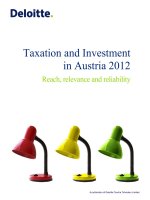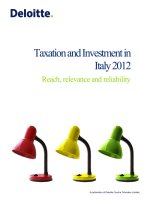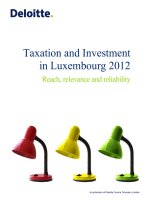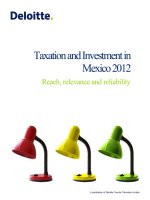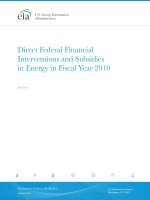TRANSFER PRICING AND VALUATION IN CORPORATE TAXATION: Federal Legislation vs Administrative Practice pptx
Bạn đang xem bản rút gọn của tài liệu. Xem và tải ngay bản đầy đủ của tài liệu tại đây (1.28 MB, 200 trang )
Transfer Pricing and Corporate Taxation
Elizabeth King
Transfer Pricing
and Corporate Taxation
Problems, Practical Implications
and Proposed Solutions
123
Elizabeth King
Beecher Consulting, LLC
9 Beecher Road
Brookline, MA 02445
USA
www.beecherconsultinggroup.com
ISBN: 978-0-387-78182-2 e-ISBN: 978-0-387-78183-9
DOI: 10.1007/978-0-387-78183-9
Library of Congress Control Number: 2008937177
c
Springer Science+Business Media, LLC 2009
All rights reserved. This work may not be translated or copied in whole or in part without the written
permission of the publisher (Springer Science+Business Media, LLC, 233 Spring Street, New York,
NY 10013, USA), except for brief excerpts in connection with reviews or scholarly analysis. Use in
connection with any form of information storage and retrieval, electronic adaptation, computer
software, or by similar or dissimilar methodology now known or hereafter developed is forbidden.
The use in this publication of trade names, trademarks, service marks, and similar terms, even if
they are not identified as such, is not to be taken as an expression of opinion as to whether or not
they are subject to proprietary rights.
Printed on acid-free paper
springer.com
For Ella, an extraordinary person
and a wonderful daughter
Acknowledgements
I have worked with many people—clients, attorneys and international examiners,
fellow transfer pricing economists and others—over the years, all of whom have
contributed greatly to my understanding of the issues addressed in this book. I
thank all of these individuals for their professionalism, their willingness to share
their knowledge, and their friendship. I would also like to thank several people for
their extremely helpful and insightful comments on this manuscript. Confidential-
ity constraints prevent me from mentioning anyone by name. Finally, my profound
thanks to Marianne Burge, in memoriam, for her mentoring and personal friendship.
USA Elizabeth King
vii
Contents
1 Introduction 1
Part I Economic and Accounting Rates and Concepts Should
Not be Conflated
2 Economic vs. Accounting Profit Rates 7
3 Overview and Critique of Existing Transfer Pricing Methods 11
3.1 ComparableProfitsMethodandTNMM 11
3.1.1 DescriptionofCPMandTNMM 12
3.1.2 Circumstances when CPM and TNMM Are Applied . . . . . . 14
3.1.3 Underlying Economic Rationale . . . . . 14
3.1.4 Critique of Economic Reasoning . . . . 15
3.1.5 SummaryandPracticalImplications 17
3.2 Resale Price and Cost Plus Methods . 17
3.2.1 Circumstances when Resale Price and Cost Plus
Methods Apply . . . . . 18
3.2.2 Description of Resale Price and Cost Plus Methods . . . . . . . 19
3.2.3 Underlying Economic Rationale . . . . . 19
3.2.4 Critique of Economic Reasoning . . . . 20
3.2.5 SummaryandPracticalImplications 21
3.3 Comparable Uncontrolled Price Method . . . . . 22
3.3.1 Description of Comparable Uncontrolled Price Method . . . 22
3.3.2 Underlying Economic Rationale . . . . . 23
3.3.3 Critique of Economic Reasoning . . . . 23
3.3.4 SummaryandPracticalImplications 26
3.4 ServicesCostMethod 26
3.4.1 DescriptionofServicesCostMethod 27
3.4.2 Rationale for Services Cost Method . . 28
3.5 Profit Split Methods . . . . 29
3.5.1 Residual Profit Split Method . 29
3.5.2 ComparableProfitSplitMethod 31
ix
x Contents
3.5.3 SummaryandPracticalImplications 32
3.6 Proposed Cost-Sharing Regulations and Coordinated Issue Paper . . 32
3.6.1 Income Method. 35
3.6.2 Acquisition Price Method . . . 36
3.6.3 MarketCapitalizationMethod 36
3.6.4 Critique 37
3.7 Global Dealing Regulations and Notice 94–40 . . . . 41
3.7.1 Circumstances in Which the Proposed Global Dealing
Regulations and Notice 94–40 Apply . . . . . 41
3.7.2 Description of Notice 94–40 and Proposed Global
DealingRegulations 43
3.7.3 Underlying Economic Rationale . . . . . 45
3.7.4 CritiqueofFormularyMethod 45
3.7.5 SummaryandPracticalImplications 48
Part II Alternative and Supplementary Approaches to Transfer Pricing
4 Some Alternative Approaches to Transfer Pricing 51
4.1 Modified Comparable Uncontrolled Price Method 53
4.2 Numerical Standards . . . 54
4.3 Required Return on Debt and Equity Capital . 55
4.3.1 Required Return on Equity . . 56
4.3.2 CostofDebt 60
4.3.3 Non-CashChargesandInvestment 61
4.3.4 Data Requirements . . 61
4.3.5 Summary 61
4.4 JointVenture-BasedProfitSplit 62
4.5 Financial or Tangible Asset-Based Profit Split 63
4.6 Franchise Model . . . . . . . 63
4.7 Summary 64
Part III Case Studies
5 Intercompany Sale of Diamonds 67
5.1 SummaryofKeyFacts 68
5.1.1 Historical Dominance of De Beers . . . 68
5.1.2 The Decline of De Beers’ Role and the Emergence of
ParallelPrimaryMarkets 69
5.1.3 Producers’ and Sightholders’ Branding and Design
Development Initiatives . . . . . 72
5.1.4 Pricing Dynamics: Primary, Secondary and Retail Markets 75
5.1.5 Functional Analysis of FP, IS and USS . . . 77
5.2 TransferPricingIssues 79
Contents xi
5.3 Analysis Under Existing Regime . . . . 79
5.3.1 FP’s Intercompany Sales of Rough Stones to IS . . . 80
5.3.2 IS’ Sales of Generic Polished Stones to USS . . . . . 81
5.3.3 IS’ Pricing of Proprietary Polished Stones Sold to USS . . . 85
5.4 Analysis Under Alternative Regime . . 85
5.4.1 FP’s Intercompany Sales of Rough Stones to IS . . . 85
5.4.2 IS’ Sales of Non-Proprietary Polished Stones to USS . . . . . 86
5.5 Comparison 88
6 Intercompany Sale of Medical Devices 89
6.1 SummaryofKeyFacts 89
6.1.1 BusinessUnitA:In-HospitalMonitoringSystems 90
6.1.2 BusinessUnitB:OutpatientMonitoringDevices 91
6.2 TransferPricingIssues 93
6.3 Analysis Under Existing Regime . . . . 93
6.3.1 FS’ Sales of Tangible Property to USP . . . 93
6.3.2 USP’s Sales of Tangible Property to FS . . . 95
6.4 Analysis Under Alternative Regime . . 98
6.5 Comparison 99
7 Performance of Intercompany Services 101
7.1 SummaryofKeyFacts 102
7.2 TransferPricingIssues 104
7.3 ValueofCustomerRelationships 104
7.3.1 DecliningAveragePrices 106
7.3.2 Rapid Rates of Technological Change 108
7.3.3 EstablishedCustomerRelationships 109
7.4 Analysis Under Existing Regime . . . . 110
7.4.1 ApplicationofBestMethodRule 110
7.4.2 Application of Selected Method: CRM Services . . 111
7.4.3 Application of Selected Method: R&D Services . . 112
7.5 Analysis Under Alternative Regime . . 113
7.6 Comparison 114
8 Replication of Internet-Based Business Model 115
8.1 SummaryofKeyFacts 115
8.1.1 USP:BusinessDevelopmentGroup 116
8.1.2 USP: Account Management Group . . 116
8.1.3 USP:MarketingGroup 117
8.1.4 USP: Information Technology Group 117
8.1.5 USP:CustomerService 117
8.1.6 USP:Legal 118
8.1.7 USP: Finance, Tax, Internal Audit and Back-Office . . . . . . . 118
8.1.8 FS 118
8.2 TransferPricingIssues 118
xii Contents
8.3 Analysis Under Existing Regime . . . . 119
8.4 Analysis Under Alternative Regime . . 120
8.5 Conclusions . . . 123
9 Sale of Assets with Embedded Intellectual Property 125
9.1 SummaryofKeyFacts 125
9.2 TransferPricingIssues 129
9.3 Analysis Under Existing Regime . . . . 129
9.4 Analysis Under Alternative Regime . . 132
9.4.1 USS’EstimatedCostofEquityCapital 133
9.4.2 EstimatedValueofUSS’EquityCapital 133
9.4.3 CostofDebt 134
9.4.4 Required Return on Capital Assuming Statutory
TaxRateApplies 134
9.4.5 Adjustments to Reflect Loss Carryforwards,
Other Firm-Specific Factors . . 135
9.5 Comparison 135
10 Provision of CDN Services to Third Parties 137
10.1 SummaryofKeyFacts 137
10.2 TransferPricingIssues 140
10.3 Analysis Under Existing Regime . . . . 140
10.4 Analysis Under Alternative Regime. . 141
10.5 Additional Analysis Under Alternative Regime . . . 143
10.6 Comparison 144
11 Global Trading of Commodities 145
11.1 SummaryofKeyFacts 145
11.1.1 DescriptionofNaturalGasMarkets 145
11.1.2 DescriptionofAluminaandAluminumMarkets 147
11.1.3 Core Assets and Skills . . . . . . 148
11.1.4 Recent Developments and Their Effect on the Relative
Importance of Core Assets and Skills . . . . . 151
11.1.5 Effects of Developments on Trading Activities 153
11.1.6 Division of Labor and Risks Among Group Members . . . . . 154
11.2 TransferPricingIssues 155
11.3 Analysis Under Existing Regime . . . . 155
11.4 Analysis Under Alternative Regime. . 156
11.5 Comparison 160
12 Decentralized Ownership of Intellectual Property 161
12.1 SummaryofKeyFacts 162
12.2 TransferPricingIssues 164
12.3 Analysis Under Existing Regime . . . . 165
Contents xiii
12.3.1 Assuming USP and FS Act to Maximize Their
Individual Profits . . . . 165
12.3.2 Assuming FS and USP Act as Joint Venture Partners . . . . . 166
12.4 Analysis Under Alternative Regime. . 171
12.4.1 KeyTermsofJVAgreements 172
12.4.2 Summary of Qualitative Observations 173
12.4.3 Quantitative Analysis 174
12.5 Analysis Under 2005 Proposed Cost-Sharing Regulations . 175
12.5.1 Income Method . 176
12.5.2 MarketCapitalizationMethod 179
12.6 Comparison 179
Part IV Conclusions
13 Concluding Observations 183
Index 187
Part I
Economic and Accounting Rates
and Concepts Should Not be Conflated
Chapter 2
Economic vs. Accounting Profit Rates
This chapter contains a brief overview of the key differences between economic
and accounting measures of profit rates, and the “big picture” practical implications
of substituting accounting measures for economic measures in the transfer pricing
regulations.
The transfer pricing methodologies written into the U.S. and OECD regulations
and guidelines are loosely founded on economic concepts of equilibrium under spe-
cific competitive conditions. These concepts are taken to justify comparisons of rates
of return (and other “profit level indicators”) across firms. Such comparisons are the
cornerstone of our current transfer pricing regimes. More particularly, individual
members of a multinational firm are generally likened to a set of quasi-comparable
standalone companies, and their gross or operating profits are determined, for tax
purposes, by imputing the independent sample companies’ rates of return, gross
margins, operating margins or other measures of profits thereto.
In theory, economic rates of return in product markets are equalized (albeit only
in the infamous “long run” under competitive conditions). However, as noted, the
U.S. and OECD transfer pricing regulations and guidelines substitute accounting
measures of profit, rates of return and asset values for economic profits, rates of
return and asset values. As described below, accounting measures do not play the
same signaling and resource allocation roles that economic rates of return play in
an economy. Therefore, they would not be equalized even in competitive markets
poised in long–run equilibrium, much less in the imperfectly competitive markets
in various states of disequilibrium that are the norm. Stated differently, there is no
reasonable basis for assuming that one firm will earn the same accounting rate of
return as a similarly situated competitor. This observation applies equally to other
accounting measures of profit.
The fields of economics and accounting serve very different purposes. Microe-
conomic and financial theories seek to explain the allocation of resources in an
economy through firm, consumer and investor behavior and market mechanisms.
Economic profits drive firm behavior and lead to the maximization of shareholders’
wealth (and, thereby, their lifetime consumption). The calculation of such profits
reflects the actual timing of investments (rather than smoothing out periodic capi-
tal expenditures via depreciation) and incorporates all costs, including the cost of
E. King, Transfer Pricing and Corporate Taxation,
DOI 10.1007/978-0-387-78183-9
2,
C
Springer Science+Business Media, LLC 2009
7
8 2 Economic vs. Accounting Profit Rates
equity capital (and, potentially, other opportunity costs). The economic profit rate
is defined as that rate which equates (a) the discounted present value of forecasted
after-tax free cash flows generated by a given investment project with (b) the initial
outlays required.
1
It is extremely difficult, if not impossible, to quantify a firm-wide
economic profit rate as a practical matter.
Under conditions of free entry and exit, and absent financing constraints, firms
will continue to enter a given market until the net present value of market participa-
tion (that is, the present value of projected after-tax free cash flows, discounted at the
opportunity cost of capital and reduced by the initial investment required) is driven
to zero. Until this point is reached, incumbent firms will earn positive economic
profits (i.e., profits in excess of a “normal” return), and shareholders’ wealth will
be increased thereby. Through the process of market entry, additional resources are
dedicated to the manufacture of those products that consumers value more highly
than the resources necessary to produce them.
Accounting analyses present a snapshot of firm performance at a point in time, or
generally over a relatively short period of time, to facilitate “mid-course corrections”
and incremental decision-making on the part of management and shareholders.
Accounting rates of return are computed as the ratio of operating profits to total
assets, fixed assets or some other measure of the book value of resources committed
by the firm. Costs are measured by explicit expenditures only, and one attempts to
match revenues and the expenditures necessary to generate them on a year-by-year
basis. As such, assets are depreciated over their useful lives, in lieu of deducting
investment outlays in full when they are made. Firms generally do not maximize
their accounting rates of return (or their ratios of operating profits to revenues or
costs, or gross profits to cost of goods or operating expenses), because such courses
of action will not result in the highest possible shareholder value. Therefore, as
noted, there are no market mechanisms at work to equalize these profit level indi-
cators across firms, and, by implication, no particular reason to expect similarly
situated firms to earn the same accounting rates of return, operating margins or
operating markups, as noted.
The use of accounting measures of profit to determine multinational firms’
country-specific income tax liabilities under profits-based methods has several
important practical implications, enumerated below.
(1) Tax authorities in different jurisdictions are likely to allocate individual multi-
national firms’ consolidated income across countries in different ways. This
statement would be true even if tax authorities utilized the same transfer pricing
methodology, given the sensitivity of one’s results to the particular “comparable
companies” included in one’s sample (and, in the case of the CPM, the particular
profit level indicator used). However, as a practical matter, tax authorities are
likely to use different transfer pricing methodologies in analyzing a given case.
1
In this context, free cash flow, constituting income that actually accrues to investors, is defined
as the after-tax cash flows earned by the legal entity under consideration, assuming that it had no
debt.
2 Economic vs. Accounting Profit Rates 9
Most countries endorse the arm’s length standard in principle, and the U.S.
and OECD provisions contain the same specific set of transfer pricing method-
ologies (discussed at length in Chapter 3). However, the IRS has a clear
predilection to use one particular profits-based method (the CPM), while OECD
countries prefer transactions-based methods. Different approved methodologies
will generally produce different allocations of income, because the assumed
unifying foundation across methods—primarily the basic concept of market
equilibrium—does not in fact apply. The large number of cases handled by the
competent authorities of different countries attests to this conundrum, which in
turn creates the potential for double taxation on a significant scale.
(2) Individual multinational corporations cannot accurately anticipate their
country-specific tax liability in the absence of an Advance Pricing Agreement.
2
Corporate taxpayers and tax authorities, respectively, also frequently utilize
different firm samples and/or transfer pricing methodologies to determine
their tax liability (taxpayers before an audit and tax authorities during an
audit). Because the use of different samples and/or methods will often produce
inconsistent results, firms acting in good faith may report substantially less
income in a given jurisdiction than the tax authority in that jurisdiction believes
is warranted.
(3) The current transfer pricing regime produces inequitable results. Because the
existing transfer pricing laws and regulations are not based on defensible eco-
nomic principles, or on transparent rules that all countries apply uniformly,
they produce arbitrary results. Arbitrary apportionments of multinational firms’
income across the countries in which they operate are inherently inequitable.
(4) Multinational and domestic firms are not treated uniformly for tax purposes.
In the abstract, the arm’s length principle appears to ensure that domestic and
multinational firms will be treated uniformly for tax purposes, essentially by
definition. However, individual standalone competitors in a given market often
report markedly different operating results in the same reporting period. By
requiring individual members of a multinational group to report gross margins,
markups or accounting rates of return that are contained in the interquartile
range of third parties’ results (a U.S. regulatory provision that the OECD Guide-
lines do not endorse), multinational firms are treated more favorably for tax
purposes than a subset of their domestic counterparts, and less favorably than
others.
Inequity is inherently problematic, and uncertainty is costly, both for tax author-
ities and individual corporations and from an economy-wide perspective. Explicit
costs, from tax authorities’ perspectives, include costs incurred in conducting audits
and analyzing transfer pricing issues, and in resolving conflicts over income alloca-
tions with their opposite numbers in other tax jurisdictions. Moreover, to reduce the
2
An Advance Pricing Agreement, as the term suggests, is a vehicle for tax authorities and firms to
agree well in advance of an audit on a particular transfer pricing methodology and the way that it
will be applied, thereby minimizing disputes at a later date.
10 2 Economic vs. Accounting Profit Rates
likelihood of penalties, firms generally commission costly transfer pricing studies,
and, as part of this process, make their personnel available to respond to analysts’
questions and requests for documentation and information. Inasmuch as uncertain-
ties regarding tax liability require firms to set aside funds that would otherwise be
invested productively, they also entail substantial opportunity costs. Lastly, firms
maximize their after-tax free cash flows. Their inability to accurately anticipate their
effective tax rates in individual countries, whether due to double taxation or sim-
ply to inconsistent allocations of income across jurisdictions (that are subsequently
adjusted without penalties), may distort investment decisions.
Chapter 3
Overview and Critique of Existing Transfer
Pricing Methods
In this Chapter, we provide an overview of the current transfer pricing regulations
pertaining to intra-group transfers of tangible and intangible property, the perfor-
mance of services, cost-sharing and global dealing. Our discussion consists of (a) a
description of individual methodologies and the circumstances in which they are
applied; (b) a review of the economic rationale for each methodology; (c) a critique
of such rationale; and (d) an assessment of practical implications.
3.1 Comparable Profits Method and TNMM
The U.S. and OECD transfer pricing regulations and guidelines sanction five trans-
fer pricing methodologies:
1. The comparable profits method or “CPM” (referred to in the OECD Guidelines
as the transactional net margin method or “TNMM”);
2. The resale price method or “RPM”;
3. The cost plus method;
4. The comparable uncontrolled price (or “CUP”) method; and
5. The profit split method.
Taxpayers are also permitted to establish fees for intercompany services rendered
to affiliates based on costs alone (without a profit element) under certain circum-
stances. Affilated lenders may charge a published safe harbor floating loan rate
(the “Applicable Federal Rate”), or, alternatively, they may determine the prevailing
market loan rate given the credit rating of the borrower and the loan terms.
The U.S. transfer pricing regime also encompasses intra-firm “cost-sharing” and
“global dealing” as special cases, addressed in separate provisions. Cost-sharing
regulations govern circumstances in which related companies jointly contribute
to research and development activities, and are assigned specific, non-overlapping
ownership rights in the research results. The term “global dealing operation” refers
to multinational financial intermediaries that buy and sell financial products, manage
E. King, Transfer Pricing and Corporate Taxation,
DOI 10.1007/978-0-387-78183-9
3,
C
Springer Science+Business Media, LLC 2009
11
12 3 Overview and Critique of Existing Transfer Pricing Methods
risk and execute transactions on behalf of customers.
1
The proposed global dealing
regulations do not formally encompass the global trading of physical commodities
(as distinct from financial products), although “the IRS solicit[ed] comments on
whether these regulations should be extended to cover dealers in commodities ”
2
In this section, we consider the merits and shortcomings of the CPM, frequently
the IRS’ and U.S. practitioners’ method of choice. For those readers who are not
familiar with the U.S. and OECD transfer pricing regulations, certain key terms are
defined below:
r
A “controlled group of companies” is a multinational firm.
r
A “tested party” is an individual member of a controlled group that one selects to
be the subject of analysis under certain transfer pricing methods. It is generally
the entity that owns little or no intangible assets and performs comparatively
simple functions.
r
A “profit level indicator” refers to one of several financial ratios that constitute
accounting measures of operating results.
r
The “arm’s length standard” is the guiding principle underlying all transfer pric-
ing methods. It requires individual members of a controlled group of compa-
nies engaging in intra-group transactions to charge the same prices, fees, and
royalty or loan rates in such transactions that they would charge unafffiliated
companies.
3.1.1 Description of CPM and TNMM
The CPM is used to establish arm’s length prices or royalty rates for (a) tangible
property sold to, (b) intangible property licensed or otherwise transferred to, or
(c) services performed on behalf of, affiliated companies. Application of the CPM
entails assembling a sample of standalone companies that are similar to the tested
party principally in terms of resources employed and risks assumed. Functional and
product comparability between the tested party and the unaffiliated companies with
which it is compared is considered significantly less important under the CPM than
under other transfer pricing methods.
3
Unaffiliated firms need only perform broadly
similar functions and operate in broadly similar product markets as the tested party.
1
More specifically, as defined in the relevant proposed regulations, a global dealing operation
“consists of the execution of customer transactions, including marketing, sales, pricing and risk
management activities, in a particular financial product or line of financial products, in multiple
tax jurisdictions and/or through multiple participants The taking of proprietary positions is not
included within the definition of a global dealing operation unless the proprietary positions are
entered into by a regular dealer in securities in its capacity as such a dealer ”. See Prop. Treas.
Reg. 1.482-8(a)(2).
2
Ibid.
3
See Treas. Reg. Section 1.482-5(c)(2)(ii) and (iii).
3.1 Comparable Profits Method and TNMM 13
In a second series of steps, one (a) computes accounting rates of return (or one
of several other profit level indicators) for each sample company
4
; (b) applies the
resulting arm’s length profit level indicators to the tested party’s corresponding
denominator (operating assets, sales, total cost, etc.); (c) establishes a range of the
tested party’s potential arm’s length results thereby (the “arm’s length range”); (d)
determines the interquartile range of such results; and (e) generally selects a profit
level contained in the interquartile range. This level of profitability directly deter-
mines the tested party’s tax liability; its affiliated counterparty’s operating income
and tax liability are determined as a residual.
5
Application of the CPM to establish arm’s length services fees entails essentially
the same steps, except that the sample selection criteria (or “comparability require-
ments”) differ, and the U.S. Temporary Regulations favor a different profit level
indicator. The Temporary Regulations emphasize accounting consistency for sam-
ple selection purposes under the CPM as applied to services, rather than resources
employed and risks assumed.
6
The use of similar intangible assets in performing
the subject services, if any, is also an important sample selection criterion. Whereas
an accounting rate of return is the profit level indicator of choice under the CPM
vis-a-vis intra-group tangible or intangible property transfers, operating profits over
total cost is the preferred profit level indicator vis-a-vis services. This preference
presumably reflects the fact that services providers often employ limited assets, and
do not consistently report cost of services separately from total cost.
The OECD Guidelines’ TNMM closely resembles the CPM, although the Guide-
lines do not favor the use of statistical tools, such as the interquartile range, to select
a particular value within the arm’s length range. Rather, the Guidelines focus on
comprehensive comparability analyses (a point forcefully reiterated in the series
of Draft Issue Notes released by the OECD’s Center for Tax Policy and Admin-
istration on May 10, 2006).
7
More generally, the OECD Guidelines take a less
formulaic approach to comparability standards and differentiate between methods
in establishing comparability criteria to a lesser extent. In all cases, the character of
the property or service, the functions performed by the parties, contractual terms,
4
Under the U.S. regulations, an accounting rate of return is the preferred profit level indicator for
purposes of applying the CPM to transfers of tangible or intangible property. Other profit level
indicators include operating profits to sales or total cost, gross profits to operating expenses, etc.
5
Application of the CPM to establish arm’s length royalty rates reflects the proposition, incorpo-
rated into the U.S. transfer pricing regulations, that an unaffiliated licensee would not retain any
income attributable to the licensed intangible asset. Rather, all such income would be transferred
to the licensor by means of royalty payments. See Treas. Reg. Section 1.482-(4)(f)(2).
6
However, the examples given in Treas. Reg. Section 1.482-9T(f)(3) to illustrate how the compa-
rability requirements should be applied indicate that the CPM is the preferred method when one
cannot ascertain whether unaffiliated companies follow the same accounting conventions as the
tested party.
7
See Comparability: Public Invitation to Comment on a Series of Draft Issue Notes,Centerfor
Tax Policy and Administration, Organization for Economic Cooperation and Development, May
10, 2006.
14 3 Overview and Critique of Existing Transfer Pricing Methods
economic circumstances and business strategies should be considered in selecting
sample companies.
3.1.2 Circumstances when CPM and TNMM Are Applied
As originally conceived, the CPM and TNMM were to be used only when the com-
parability standards applied under other methods could not be satisfied or account-
ing ambiguities precluded their use. OECD member countries often take a dim
view of the CPM/TNMM. However, it is very widely applied in the United States,
accounting for the substantial majority of transfer pricing cases analyzed by IRS
agents in the field, and almost all of the Advance Pricing Agreements negotiated
among companies, the National Office of the IRS and tax authorities in other juris-
dictions. (For the sake of decorum, the methodology may be referred to differently
in the accompanying documentation, such as a resale price method with adjustments
for higher-than-normal operating expenses.)
There are at least two reasons for the CPM’s widespread use in the United States.
First, as a practical matter, IRS agents in the field and National Office personnel
have tended to apply higher comparability standards under the resale price and cost
plus methods than a strict reading of the regulations would appear to require, sig-
nificantly limiting their applicability. Moreover, the CPM is amenable to “cookie-
cutter” analyses that apply across a range of transactions and industries. As such, it
is cost-effective for corporations and the IRS alike. (Hence, if history is a reliable
guide, U.S. practitioners will also frequently resort to the CPM to establish arm’s
length services fees when the services cost method, which provides for a cost-based
fee, cannot be used.)
3.1.3 Underlying Economic Rationale
The CPM and TNMM depend on the following key assumptions for their economic
legitimacy:
1. Product markets are generally competitive and in equilibrium;
2. For this reason, accounting rates of return (defined in the U.S. regulations as
operating profits divided by operating assets) are equalized across manufacturing
or distribution firms in broadly similar product markets;
3. Service markets are generally competitive and in equilibrum; and
4. Under these circumstances, operating markups over total cost are equalized
across service providers rendering broadly similar services.
Such reasoning has also been generalized, to some degree, to the other profit level
indicators used in applying the CPM to transactions in tangible and intangible prop-
erty. However, in principle, greater functional comparability is required when using
a financial ratio other than accounting rates of return under the U.S. regulations.
3.1 Comparable Profits Method and TNMM 15
One might argue that the CPM and TNMM are not based on economic notions
of equilibrium and specific market structure assumptions. Admittedly, the drafters
are not explicit on this point, beyond asserting (inaccurately) that “[a]n operating
profit represents a return for the investment of resources and assumption of risks”
(thereby equating accounting profits per annum with the discounted present value of
free cash flows),
8
and sanctioning comparisons of accounting rates of return across
firms. However, if one determines the tax liabilities of individual affiliated compa-
nies by imputing to them accounting rates of return realized by similarly situated
unaffiliated companies, there must be some expectation that accounting rates of
return (and other profit level indicators) will be uniform across firms. Other than
an unvarnished assumption to this effect (which is belied by the wide arm’s length
ranges that one routinely observes in practice), or the belief that affiliated companies
can legitimately be likened to a “median” unaffiliated firm for purposes of determin-
ing their tax liabilities, an economic rationale is all that remains.
3.1.4 Critique of Economic Reasoning
As previously noted, in theory, economic rates of return, as distinct from accounting
rates of return, are equalized, albeit only in competitive markets and in equilibrium.
9
There are no market mechanisms at work to equalize accounting-based profit level
indicators across firms, and, by implication, no reason to expect similarly situated
firms to earn the same accounting rates of return, operating margins or operating
markups, even in competitive markets.
The corollary assumptions that product markets are generally competitive and
normally in long-run equilibrium are equally invalid. “Perfect” competition is char-
acterized by (a) a large number of incumbent firms, each of which sells an undiffer-
entiated product, makes up a very small share of the total market and can therefore
take selling prices as fixed (that is, independent of its own output decisions); (b)
potential entrants do not face barriers to entry (or existing firms, impediments to
expansion); (c) buyers are numerous, knowledgeable and can obtain the undifferen-
tiated product from a number of different suppliers without bearing additional costs;
and (d) buyers themselves are indistinguishable from the perspective of producers.
As a consequence of these characteristics, product prices will be equalized and, over
time, firms will be forced to utilize the (same) most efficient technology available.
More loosely speaking, product markets can generally be considered competitive
if products are homogenous, incumbent firms can readily expand or new firms can
enter (even if only with the investment of potentially significant resources and over
a potentially long period of time), buyers are well informed as to their alternative
sources of supply, and switching suppliers is not excessively costly.
8
See Treas. Reg. Section 1.482-5(c)(2)(ii).
9
However, as noted, the economic rate of return is a much more difficult magnitude to measure
than an accounting rate of return, particularly on a firm-wide basis.
16 3 Overview and Critique of Existing Transfer Pricing Methods
Very few product markets were competitive in the strict sense when the basic
tenets of microeconomic theory were first put forward by Alfred Marshall circa
1891. However, the discrepancy between archetype and economic reality was not
as marked then as it is now. Firms have become progressively larger, vertically
integrated and both horizontally and geographically diversified. Products other than
commodities are routinely differentiated along numerous dimensions (trademarks,
functionality, levels of customer service and technical support, product quality,
etc.). As such, the pure competitive market model has become largely a figment of
the imagination (with the exception of securities markets and commodity markets
in some instances). In fact, relatively few product markets are competitive in the
broader sense described above. While this statement is probably more obviously
apparent vis-a-vis consumer product markets, it is often true of producer product
markets as well. Switching costs are relatively common among producer products,
as is product differentiation in certain forms.
Moreover, the traditional concept of long-run equilibrium is a theoretical con-
struct, rather than a description of real product markets at any point in time. It
implies a stasis in the number of firms operating in a given market, the types of
products they produce, the technologies they utilize, the terms of competition,
etc. In most markets, new product introductions are the norm, firms continuously
strive to improve their production technologies and techniques, barriers to foreign
competition (e.g., quotas and tariffs) are revisited, competitors merge, and reg-
ulatory requirements change. Hence, even supposing that product markets were
generally competitive, economic rates of return would only be equalized in the long
run, not on a year-by-year basis. Product markets are almost invariably in a state
of disequilibrium.
Two other shortcoming with the use of accounting rates of return in a transfer
pricing context also bear noting, the second of which is widely recognized:
1. Affiliated manufacturers’ accounts receivables and affiliated distributors’
accounts payables reflect intercompany pricing. As such, their asset bases,
inclusive of working capital, will potentially be distorted by intercompany
pricing and cannot reliably be used for purposes of evaluating such pricing.
2. The book value of assets, as shown on financial statements, reflects particular
accounting conventions, over which firms have a certain amount of discretion. If
unaffiliated firms utilize different conventions (e.g., different depreciation meth-
ods), all other things equal, their accounting rates of return will differ for this
reason alone. Moreover, accounting rates of return will be strongly influenced
by the age of operating assets through two mechanisms: (a) the price paid for
individual assets at the outset (in that prices vary over time) and (b) the extent to
which the assets have been written off. Lastly, individual firms rely on intangible
assets to widely differing degrees.
10
10
Certain of the limitations noted above regarding accounting rate of return measures are acknowl-
edged in the U.S. Regulations, and one is cautioned to consider them in evaluating comparability.
However, as a practical matter, the potential for distortions is so great as to preclude the use of
3.2 Resale Price and Cost Plus Methods 17
Clearly, differences in accounting rates of return across firms could not be
ascribed solely to transfer pricing, even if such comparisons were otherwise
meaningful.
3.1.5 Summary and Practical Implications
In short, the imputation of accounting rates of return, operating markups or oper-
ating margins derived from unaffiliated companies to individual members of con-
trolled groups, to determine the latter firms’ tax liabilities, cannot be justified by
economic principles. Moreover, the implicit assumption that such financial ratios
will be equalized across small samples of firms on a year-by-year basis is inde-
fensible on empirical grounds alone, in view of the wide range of results reported
by sample companies in most instances. Consequently, a tested party’s tax liability
under the CPM/TNMM is entirely dependent on the particular profit level indicator
chosen and the specific unaffiliated companies included in one’s firm sample. Differ-
ent profit level indicators and/or different sample companies can produce markedly
different allocations of income across countries. Moreover, because the comparabil-
ity criteria applied under the CPM and TNMM are not restrictive, the universe of
potential sample companies is quite large.
Therefore, even if companies correctly anticipate that the IRS will utilize the
CPM in assessing their tax liability after the fact, they will not be able to determine
with a reasonable degree of certainty, before the fact, how much taxable income they
should report in the United States. As previously noted, this state of affairs imposes
both explicit and opportunity costs, the former in the form of professional and legal
fees (and, potentially, double taxation and penalties), and the latter resulting from
monies held in reserve, in conformity with the FASB’s standards of practice vis-
a-vis uncertain tax liabilities. Moreover, if firms maximize their after-tax free cash
flows, and gauge their country-specific tax liabilities incorrectly, this will result in a
sub-optimal allocation of resources.
3.2 Resale Price and Cost Plus Methods
Consider next the resale price and cost plus methods. Both are transactions-based
methods that the OECD favors over the CPM/TNMM.
accounting rates of return in most cases involving manufacturing firms. Because distributors’
assets are composed principally of inventories and accounts receivables, for which book value
approximates market value, the potential for distortion is not as problematic, except as regards
intercompany pricing.
18 3 Overview and Critique of Existing Transfer Pricing Methods
3.2.1 Circumstances when Resale Price and Cost Plus
Methods Apply
The resale price and cost plus methods (and, under the U.S. Temporary Regula-
tions, the gross services margin method and the cost of services plus method) can
be applied under the following fact patterns:
1. A single manufacturer sells similar products to both affiliated and unaffiliated
distributors;
2. A single distributor sources similar products from both affiliated and unaffiliated
suppliers;
3. A single services provider renders similar liaison or agency services (in the case
of the gross services margin method) to both affiliated and unaffiliated compa-
nies, and, if relevant, utilizes the same intangible assets in doing so;
4. A single services provider renders similar services (other than liaison services in
the case of the cost of services plus method) under the same contractual terms to
both affiliated and unaffiliated companies and utilizes the same intangible assets,
if any, in doing so;
5. Two or more manufacturers sell similar products, in one instance to affiliated
distributors, and in the other instances, to unaffiliated distributors;
6. Two or more distributors source similar products, in one instance from affiliated
suppliers and in the other instances, from unaffiliated suppliers; and
7. A group member performs routine manufacturing or distribution functions and
licenses intellectual property from another group member.
Given one of the above fact patterns, one’s choice between the resale price and
cost plus methods depends principally on whether (a) one of the group members
engages in internal arm’s length transactions, and (b) the affiliated manufacturer or
the affiliated distributor is the least complex entity (and therefore, the designated
tested party). For example, under the first fact pattern, one would ordinarily apply
the cost plus method, and under the second, the resale price method. As indicated
above, the gross services margin method generally applies when the services at issue
are intermediary in nature, and the cost of services plus method applies when the
tested party renders the same services to both affiliated and independent companies.
Under the fifth and sixth fact patterns, one’s choice between the resale price and cost
plus methods would be dictated by each group member’s ownership of intellectual
property and the relative values thereof. Under the last fact pattern, the choice of
methods depends on whether the licensee is a manufacturer or a distributor.
The U.S. regulations impose higher standards of comparability under the resale
price and cost plus methods, as compared to the CPM: Products must be “of
the same general type (e.g., consumer electronics),”
11
and the parties being com-
pared should perform similar functions, bear similar risks and operate under similar
contractual terms. As previously noted, the OECD Guidelines do not differentiate
11
See Treas. Reg. Section 1.482-3(c)(3)(ii)(B).
3.2 Resale Price and Cost Plus Methods 19
between transfer pricing methods in establishing comparability criteria to the same
degree as the U.S. regulations. Such criteria include the character of the property
or service, the functions performed by the parties, contractual terms, economic cir-
cumstances and business strategies.
3.2.2 Description of Resale Price and Cost Plus Methods
Briefly stated, under the resale price method, one compares the captive distributor’s
gross margin on product sourced from affiliated companies with its gross margin
on product sourced from unaffiliated companies. If the captive distributor does
not source similar products from both affiliated and unaffiliated companies, one
can compare its resale margin on products sourced from affiliated suppliers with
the resale margins reported by unaffiliated distributors that source similar products
from independent suppliers. An analogous comparison is made under the cost plus
method and the cost of services plus method, except that the profit level indicator
differs. More particularly, under the cost plus and cost of services plus methods, the
profit level indicator is equal to gross profits divided by cost of goods (or services)
sold.
3.2.3 Underlying Economic Rationale
Under one interpretation, the resale price method, applied to internal transactions,
presupposes that individual distributors would pay similar purchase prices to their
multiple suppliers on an arm’s length basis and charge their unrelated customers
similar selling prices. This set of assumptions, in turn, implies that (a) suppliers
operate in the same competitive market or have no binding capacity constraints
and value the subject distributor’s business relatively highly, and (b) the distribu-
tor cannot (and is not forced to) differentiate among its customers in establishing
its selling prices. If the resale price method depends on these assumptions for its
validity, gross margin comparisons would only be valid if the products generating
such margins are quite similar, not simply of the “same general type”. Similarly,
the cost plus method, applied to internal transactions, may presuppose that individ-
ual manufacturers are unable to differentiate among customers in establishing their
selling prices, and employ the same or similar technologies in producing product
for different customers. Again, under this rationale, the products on which markups
are being compared must be closely similar.
Alternatively, the economic rationale for internal comparisons of resale margins
or cost plus markups may simply be that individual distributors and manufacturers
would necessarily earn a reasonably uniform gross margin or markup across transac-
tions, consistent with the return that investors would require. As applied to external
transactions, the only economic rationale for the resale price and cost plus methods
would seem to be that market forces will equalize resale margins and gross markups
across firms.


